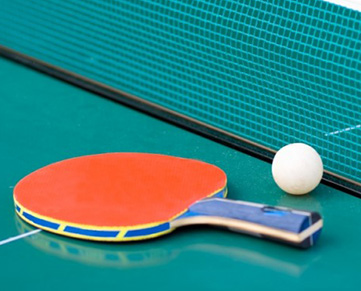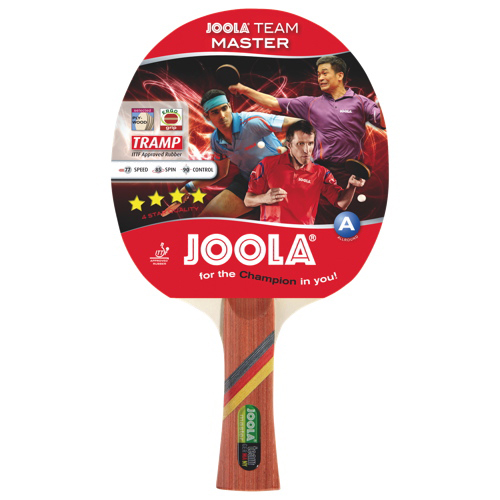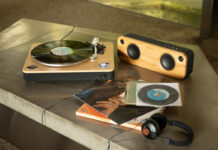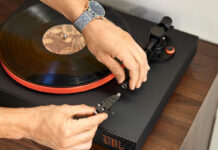 Ping Pong, or as my dad likes to call it “gnip gnop” (pronounced “geh-nip geh-nop”), wasn’t invented in China, as many believe, but came into being in the late 1880s in England when a group of upper class Victorian gentlemen created a version of tennis they could play indoors as a way to relax after dinner. At the time, the tools used to play the game were everyday objects, such as a line of books as a net, a champagne cork as a ball, and a cigar box lid as a racket.
Ping Pong, or as my dad likes to call it “gnip gnop” (pronounced “geh-nip geh-nop”), wasn’t invented in China, as many believe, but came into being in the late 1880s in England when a group of upper class Victorian gentlemen created a version of tennis they could play indoors as a way to relax after dinner. At the time, the tools used to play the game were everyday objects, such as a line of books as a net, a champagne cork as a ball, and a cigar box lid as a racket.
Thankfully, these days you don’t need to rummage around your home to find suitable objects with which you can play the game. All you need is the right table tennis equipment, some space, and a basic understanding of how to play. Before we jump into the “how” of the game, you may have noticed that I said “table tennis” in the previous sentence and not “Ping Pong” – this was not a mistake. Let me explain.
Ping Pong vs. Table Tennis
Ping Pong and table tennis are terms that are often used interchangeably, but there is a difference between the two. “Table tennis” is the actual sport. “Ping Pong” however, is a brand name of a table tennis equipment that was trademarked in 1901 by the English sports company John Jaques & Son.
John Jaques & Son are credited for manufacturing and popularizing the first table tennis sets, which they named “Ping Pong” in reference to the sound the ball made when it hit their rackets, which were made of velum stretched over an outer casing similar in structure to a drum. So, much like the brand name Kleenex is often used as a generic term to describe tissue, the brand name Ping Pong has become synonymous with the sport of table tennis. However, I’m a fan of the way “Ping Pong” rolls of the tongue, so for the purposes of this post, when I say “Ping Pong” I am referring to table tennis.
 Ping Pong set up
Ping Pong set up
The great thing about Ping Pong is that it requires minimal skill to set up, and is really as simple as unfolding the table and ensuring the net is attached correctly. That said, a Ping Pong table is 9’ long by 5’ wide, so you’ll want to make sure you set it up in a large, open room that leaves adequate space on all sides for unobstructed play. You also want to make sure that when the table is open, its hinges are locked. Otherwise your table may collapse on you right in the middle of an epic rally.
 Ping Pong equipment
Ping Pong equipment
Outside of a Ping Pong table and net, the only other pieces of equipment you need to play are two or more rackets and a ball. I was surprised to discover that rackets can be any size, shape, and weight. The only two caveats are that the racket should have one red and one black side, and the blade must be flat and rigid. That said, the majority of table tennis rackets are all very similar in size, measuring about 6” across and 10” long, including the handle.
Ping Pong rules
Now that you’ve got your table set up and locked, and a racket and ball in hand, it’s time to play. But before you start smacking that little ball back and forth, there are some rules you need to keep in mind.
- Don’t touch – Under no circumstances are you to move the table or put your hands on the table surface while the ball is in play. If you do, a point is awarded to your opponent.
- Don’t hide – You must keep the ball in plain view when you are serving. If at any point of the serve your opponent can’t see the ball, it is called a fault.
- Don’t spin – You may want to show up your opponent with your fancy skills, but the ball must not have any spin on it and must be tossed in an upward fashion when serving.
- Don’t scoop – When serving, you must hit the ball when it is travelling downwards. It’s not legal to serve the ball below the table by “scooping” it up.
Ping Pong play
There are two ways to play Ping Pong – in singles (one on one) or in doubles (two on two). Once you’ve got your opponent(s) lined up, you need to determine who is going to serve first. You can flip a coin or play Paper-Rock-Scissors … it’s really up to you. The winner, however, gets to choose whether they want to serve first or receive first. They also get to choose which side of the table they want to start on.
In singles play, the ball can be served anywhere on the table – short, long, straight or cross-court. However, in doubles play, the ball must be served diagonally from your right court to your opponent’s right court.
After deciding who serves first, each player will serve for two points. So, if Player A serves first, they will continue to serve until two points are scored. Then their opponent will serve for two points. If a net ball (called a ‘let serve’) is served, the point will be replayed; there are no limits to the number of let serves a player may serve, which I think is a fantastic rule for beginners like me!
Games are played to 11 points. Preliminary matches are typically best of five games, while championship matches are the best of seven or nine games.
Scoring points
Once your game gets going, it’s easy to lose yourself in a good rally, but there are a few things you need to keep in mind. Obviously, the idea is to get to 11 points before your opponent, but there is more than one way to earn a point. If you ace a serve or win a rally, you win a point. But, if you volley the ball before it hits the table surface, your opponent gets a point. If you hit the ball twice in succession before it goes back over the net, your opponent wins a point. If you or your clothing touches the net, your opponent wins a point. If your shot hits a wall, the ceiling, or just plain misses your opponent’s side of the table, your opponent wins a point.
When a game is tied at 10-10, it is called a “deuce” and means that you must now win by two points instead of just one. Once the game is won, you and your opponent switch sides of the table and the player who served first in the last game will now be the receiver of the serve.
Ping Pong is a great game for all skill levels and age levels. And now that it is an Olympic sport, it makes even more sense to add a table to your games room – just think, in the 2018 Summer games, you’ll have much more of an appreciation for all its nuances!
Check out all the Ping Pong tables and accessories on BestBuy.ca.




I actually own this exact table. Very sturdy and useful. Well worth the money.
In case you are like me and lose a lot of balls to random bounces you may want to look into the JOOLA Magic Balls 144 pack. Trust me it will save you a lot of angst!
Comments are closed.